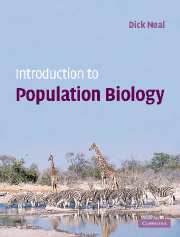Book contents
- Frontmatter
- Contents
- Preface
- Acknowledgements
- PART I Evolution by natural selection
- PART II Simple population growth models and their simulation
- PART III Population genetics and evolution
- Chapter 6 Gene frequencies and the Hardy–Weinberg principle
- Chapter 7 Mutation and the genetic variation of populations
- Chapter 8 Small populations, genetic drift and inbreeding
- Chapter 9 Migration, gene flow and the differentiation of populations
- Chapter 10 Quantifying natural selection: haploid and zygotic selection models
- Chapter 11 Applying zygotic selection models to natural systems
- Chapter 12 Polygenic inheritance, quantitative genetics and heritability
- Chapter 13 Population genetics: summary and synthesis
- PART IV Demography
- PART V Interactions between species, and the behaviour of individuals
- Glossary
- Solutions to problems
- References
- Index
Chapter 13 - Population genetics: summary and synthesis
- Frontmatter
- Contents
- Preface
- Acknowledgements
- PART I Evolution by natural selection
- PART II Simple population growth models and their simulation
- PART III Population genetics and evolution
- Chapter 6 Gene frequencies and the Hardy–Weinberg principle
- Chapter 7 Mutation and the genetic variation of populations
- Chapter 8 Small populations, genetic drift and inbreeding
- Chapter 9 Migration, gene flow and the differentiation of populations
- Chapter 10 Quantifying natural selection: haploid and zygotic selection models
- Chapter 11 Applying zygotic selection models to natural systems
- Chapter 12 Polygenic inheritance, quantitative genetics and heritability
- Chapter 13 Population genetics: summary and synthesis
- PART IV Demography
- PART V Interactions between species, and the behaviour of individuals
- Glossary
- Solutions to problems
- References
- Index
Summary
In the previous seven chapters, we have examined various factors that influence the allelic frequencies in the gene pools of populations. It is easy to become mired in the details and lose sight of the broad, overall picture. The purpose of this chapter is to summarize how genetic variation is developed, maintained and directed in populations, a process which we call microevolution, so that we can develop an overview and general understanding of the interrelationships of the various factors or processes. The scheme that we will be following is summarized in Fig. 13.1.
Evolution can be considered to be a two-step process: first, the production of genetic variation by mutations and genetic recombination and, second, an ordering of that variation by natural selection which may be influenced by processes such as genetic drift and migration.
Mutations
Genetic variation is originally created by mutations, which cause changes in the precise sequence of DNA in the chromosomes. Mutation by itself is not an important driving force of evolutionary change because mutations causing the same phenotypic change occur at very low frequencies, somewhere in the order of 1 × 10-5 to 10-8 per gamete. It would take many thousands of generations to effect a substantial change in allelic frequency as a result of mutation pressure alone (see Chapter 7). Mutation creates genetic variation in a non-directed fashion, i.e. mutations are not created in relation to their need.
- Type
- Chapter
- Information
- Introduction to Population Biology , pp. 206 - 214Publisher: Cambridge University PressPrint publication year: 2003



